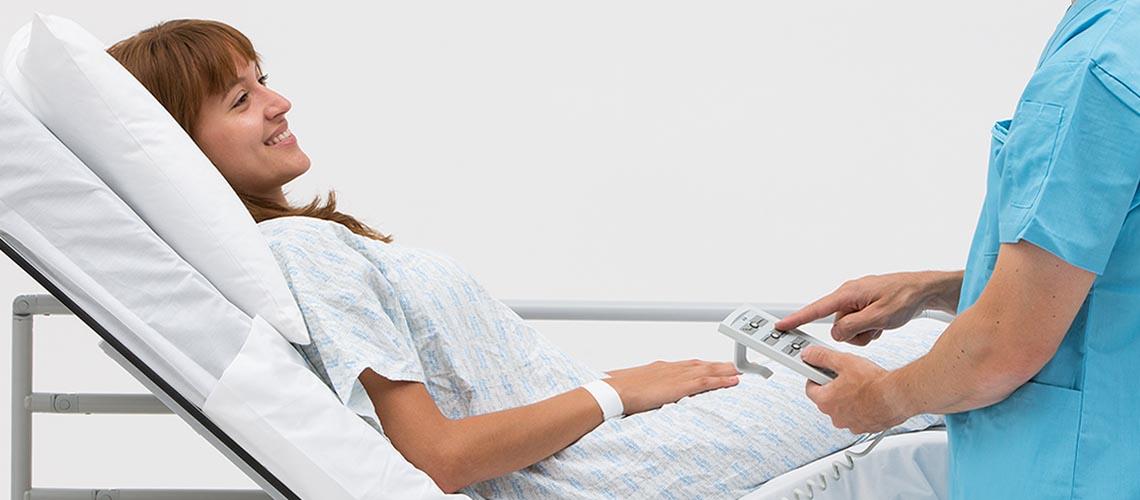Electric Stretchers, Safer and Easier
Immobilised trauma patients being treated in accident and emergency departments are often re-positioned or moved by clinical staff, usually nurses. The majority of patient platforms for trauma care while having hydraulic assistance mechanisms, still need physical input from carers when handling patients. This can lead to staff fatigue and workplace injury. Follow on effects include reduced operational efficiency and an increased corporate, legal and social risk.
Fully electric patient trolleys with battery backup reduce the manual handling burden on hospital staff without interrupting existing procedures and workflows. Their use alleviates a major cause of staff sickness absence and also relieves caregiver fatigue, promoting maximum efficiency and the best care for patients throughout a shift.
One in four nurses have taken time off work with a back injury sustained at work. UNISON estimates that annually 3,600 NHS healthcare workers are forced to retire early as a result which carries an estimated cost of £60,000 each (NHS Employers). Across the care sector, handling injuries account for over a quarter of all reported injuries to employees (Backcare).
To eliminate staff injury from patient manual handling, training and procedures have been in place for many years. Specialist managers are tasked with advising departments on best practice. Yet still, NHS staff musculoskeletal injury remains stubbornly high (NHS Employers). If department budgets do not allow for adding more personnel working in teams to share individual manual handling tasks, then better equipment will be the route to achieve a safer workplace.
The implications are felt beyond reduced staffing capacity on the ward to litigation liability that can be a significant drag on resources. NHS organisations spent almost £47 million in compensation payments in 2012, not including legal costs (Nursing Standard).
Standard hydraulic hospital trolleys still require physical effort from caregivers to lift backrests, foot pumping to raise platforms and manually repositioning limbs for comfort. Healthcare staff fatigue can lead to errors and impact performance (Garrett 2008). Demographic trends show an increase in both elderly and bariatric sections of the UK population that will mean growing patient handling issues for nurses, porters and clinicians. The number of over-80s is estimated to more than double to 6 million by 2037. In England, the proportion of men classified as obese increased from 13.2 per cent in 1993 to 24.4 per cent in 2012 (peak of 26.2 in 2010), and from 16.4 per cent to 25.1 per cent for women (peak of 26.1 in 2010) over the same timescale (NHS Confederation).
The average age of nurses is also rising: 49% of nurses were over the age of 45 in 2012, up from 33% in 2002 (Royal College of Nursing). With a rising retirement age, future procurement needs to consider the requirements of nurses well over the age of 65.
The Electric Solution
Upgrading to electric trolleys addresses all these issues at a comparable cost to hydraulic-based models.
The new Howard Wright powered M9 series with battery backup targets the causes of injury with fully electric positioning. Reducing the manual elements of patient handling procedures, particularly in emergency care also reduces the sources of health and safety risk as is mandated by the Health and Safety Executive.
The M9 Trauma and M9 Transfer have been developed in accordance with EN IEC60601-2-52:2010, the hospital bed standard, to ensure the safety of both patients and caregivers, even if the patient is unattended.
The M9 series class leading low height further confirms the attention to safety that the trolleys offer over a wide range of patient age and weight groups. The M9 Transfer hospital transport stretcher has a minimum height of 350mm. Getting on and off becomes much more straightforward when the patient’s feet can easily touch the ground as this lowers the risk of falls and can reduce their potential severity.
Patients will also appreciate the smoother operation of the electric positioning movements that have a comparable speed to hydraulic but without the jerky motion and the (lockable) ability to re-position themselves without continually requesting nurse aid.
Howard Wright Limited medical beds and trolleys have been helping save lives and care for patients throughout the world for many years with a strong reputation for robustness and durability even in the most demanding healthcare environments. Specifying quality components leads to a compelling whole of life value offer, with reliable operation and simple servicing.
The ‘Simple, Smart and Human’ design values that are applied to each new product result in elegant solutions that are intuitive to use with minimal user training. Celebrating 50 years of making human care easier in 2013-14, Howard Wright continues to produce better care outcomes for both patients and staff from their state-of-the-art in-house design and manufacturing facilities.

